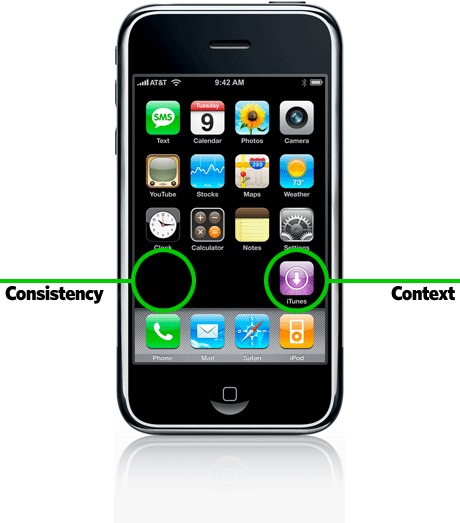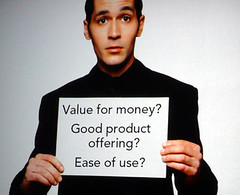Ever since we’ve hacked our iPhones, we’ve been noodling on themes for SummerBoard.
We’re happy to share six of them with you today, with more to come in the future. If you grab them, be sure to post comments to let us know what you think. Five more after the break…
1 Bit by Jared Benson
Pixels rule. What if the iPhone was released with a 1-bit display? Enjoy this old school rendition. Download it here.
Continue Reading »
Add this to digg, del.icio.us, etc.
The context versus consistency debate is not new, but it certainly doesn’t appear to be over. 37signals adds another argument to the context pile…

I read this interesting (short) article on 37signals.com concerning Apple’s placement of their new iTunes icon on the iPhone home screen. Given that the western world reads from left to right, users would expect this last icon to appear on the left side, right?… Not so says Apple, here’s why:
Read Context over Consistency at 37signals.com.
Although it’s something that the common person might not notice or ‘get’, it shows that the Apple UI folks are never asleep at the wheel and that they spend time thinking about the small details and their resulting implications. Don’t just do things automatically because tradition says we should or because the technology says it should be that way.
Add this to digg, del.icio.us, etc.
You’ve probably had this experience:
- You anticipate the arrival of a new device for weeks.
- You discuss it with your friends, read the reviews and the promised features.
- You listen to the hype; sometimes a believer, sometimes a skeptic.
- You try the device in the store. It’s got some nice features.
- You buy it.
- Your friends ask to play with it and strangers ask what it is.
- 1 week later the allure is gone. The experience has imperfections.
- 2 weeks later its weaknesses are clear. You don’t love it. There are a few cumbersome interactions and design flaws.
The iPhone stands out strongly as an exception. It definitely passes the 2 week test criteria: a) you love it more after 2 weeks than you did when you got it and b) you can’t remember life before it. (Okay, so I’m exaggerating that last point.)
Continue Reading »
Add this to digg, del.icio.us, etc.
This iPhone tip goes out to those of you following the growing “Life Hacks” movement - gaining back precious minutes of your life through efficiency practices.
We’ve all been stuck in meetings that we wish we could get out of. Well, fortunately His Steveness has designed something handy into the iPhone which will help us reclaim our lives so we can get back to doing what we _really_ want to be doing. If you have the foresight, try this before attending your next meeting:From the main menu, select Clock then Timer. Use the wheel interface to set your interval (How much of this meeting are you willing to endure?), set your ringtone and hit “Start.”
Attend your meeting. Go ahead and shut your phone down (read as: Hit the hardware button on top right) and set it on the table next to your notebook, printouts, etc. and act as interested as you can in the meeting. Resist the urge to check the timer - don’t worry, it won’t let you down. When the timer reaches zero, it will wake up your iPhone and play the ringtone. To anyone glancing over at your iPhone, the combination of idle screen wallpaper and ringtone will look convincing, even to a fellow iPhone user.
Grab it shortly into the first ring, give it a quick glance, and apologize to those left in the room.. “Sorry, I gotta take this…”
Add this to digg, del.icio.us, etc.

EMI keynote at CTIA Orlando
Eric Nicoli (CEO of EMI Group) hinted in his keynote at CTIA that his company had been “experimenting” with DRM-free music and said that their studies showed people would be willing to pay more for it. Last weeks’EMI Group announcement of an iTunes deal will make higher quality, DRM-free, tunes available for $1.29. The new offering doesn’t replace the existing $.99 DRM versions. What’s even more user-friendly is that users who own DRM versions can upgrade their tracks for $.30 each.
 Eric Nicoli also made a call for the mobile industry, specifically those in the media and entertainment realm, to take cues from Apple and address issues like value for price, making compelling products and ease of use.
Eric Nicoli also made a call for the mobile industry, specifically those in the media and entertainment realm, to take cues from Apple and address issues like value for price, making compelling products and ease of use.
Add this to digg, del.icio.us, etc.
iPods sold at a brisk pace over the 2006 holiday season, which would seem to end the recent iPod sales slump. However, Tomi Ahonen aims to blow away any speculation that the iPod is still holding on to the music player throne. The barrage of evidence from Asian, European and UK studies he presents is pretty compelling. In a nutshell, he says that while iPod sales grew 45% that music phone growth has boomed to 243%, which means that though iPod sales are growing, the iPod market share has been long overtaken by music phones and is shrinking by comparison. (SonyEricsson alone shipped 60 million musicphones compared to Apple’s 46 million iPods).
Now, you’re thinking, “but just because people own a music-capable phone, a so called music phone, do people actually use them for listening/buying music?” Well, Ahonen says yes, and backs it up with some interesting European and Asian studies. The UK study he sites says that 80% of musicphone owners are satisfied or very satisfied with them. Thus Ahonen’s argument goes: the iPod is so totally over.
He’s quick to dismiss the iPod and usher in the music phone era, but I don’t think he’s really discussing the US side of the picture…
Continue Reading »
Add this to digg, del.icio.us, etc.
There has been a lot of press and commentary on Apple’s iPhone. Deservedly so. From what has been presented thus far the iPhone is a sleek piece of hardware and software engineering as only Apple can produce it. Whether the iPhone is revolutionary, expected or somewhere in between, the discussion has focused primarily on the device’s features and interface. Much less has been said about the implications of Apple’s iPhone business strategy. Since the iPhone was announced on January 9, my thoughts have turned to the decisions that Apple has had to make in order to enter the wireless market and what may come in the wake of the iPhone’s June 2007 launch.
Why iPhone?
Apple’s decision to get into the wireless device business is not surprising. Since the launch of the iPod 5 years ago, Steve Jobs has touted the connected experience where all Apple devices and services work and play seamlessly with one another in one glorious digital ecosystem. Since the mobile phone has become the one device that no one is ever without, despite the fact that nothing about the wireless experience is very good, it was only a matter of time before Apple got into the game. “Everybody hates their phone,” Time magazine quotes Jobs as saying, “and that’s not a good thing. And there’s an opportunity there.”
Uncharted Territory
Having decided to get in the game, Apple’s most significant decision is to be a manufacturer only rather than a manufacturer + MVNO. This is curious since Apple’s brand is largely based on its control of the end-to-end consumer experience. The MVNO route would have allowed Apple to maintain the most control over the end-to-end iPhone experience, clearly important after the ROKR fiasco. However, it would also have taken Apple into uncharted territory as a wireless operator. With iPhone v.1 Steve Jobs has decided to take the path with the fewest risks and stick with what he knows Apple does best.
Continue Reading »
Add this to digg, del.icio.us, etc.
Ripped from the headlines, here’s a collection from media sources around the web. Apparently when Apple made its announcement, editors and bloggers around the world sharpened their lucky pencils and exclaimed, “Now here’s a piece just begging for a snappy headline.”
Apple’s iPhone is pretty ordinary at its core
Andrew Kantor, USAToday
Cisco Bites Into Apple Fame (video)
Forbes.com Video Network
Why it’s the Apple of everyone’s eye
Phyllis Furman, New York Daily News
Apple’s new fruit forbidden for now
Jim Rossman, The Dallas Morning News
Continue Reading »
Add this to digg, del.icio.us, etc.
“Cool, no hard hard keys!” versus “Are you kidding? No keyboard?”
First, I’m not deluded enough to think the iPhone is the holy grail of devices. They have a lot in their favor in the US, but they don’t have a smooth ride like they did with the iPod.
If you read the US blogs and tech papers, the iPhone is best thing since the personal modem. Glowing headlines like Apple Waves its Wand at the Phone, where David Pogue equates Apple to a fairy godmother, to “It’s Expected, but it’s Stunning” from the SF Chronicle.
But if you read what the Europeans and Asians are saying, this is cool, but not worth all the hype. Russell Buckley even says it’s just a music phone. Then there’s the LA Times story: “In Japan, Barely a Ripple”, which is saying that all these features (plus mobile payments) have been available in Japan for 2+ years already. (But come on, they haven’t thrown out cumbersome soft keys in exchange for full-face, multi-touch screens, have they?)
So, what is it? Is it just a music phone?
Continue Reading »
Add this to digg, del.icio.us, etc.
The web is blowing up today with content on the new iPhone. It seems everyone has a perspective, and I’m no different.
Revolutionary or not, Apple did a few things right with this iPhone debut, which I’m convinced will resonate with today’s mobile users.
Portrait-landscape orientation: As media enjoyment and management grows on the mobile platform, mobile users have had to accommodate that awkward moment when you have to physically pivot the handset in your hands in order to view an image or watch mobile TV. In those instances, there is often a sense of disorientation while the user remaps expectations for the D-Pad, and explores how to interact with softkeys, etc. By creating a device that orients itself and keeps tactile interactions consistent, they’ve created a device that feels native to both orientations.
Continue Reading »
Add this to digg, del.icio.us, etc.



 Eric Nicoli also made a call for the mobile industry, specifically those in the media and entertainment realm, to take cues from Apple and address issues like value for price, making compelling products and ease of use.
Eric Nicoli also made a call for the mobile industry, specifically those in the media and entertainment realm, to take cues from Apple and address issues like value for price, making compelling products and ease of use.